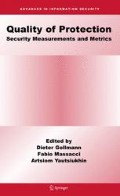Abstract
During the last years a couple of attacks on generic anonymity protocols emerged, like e.g. the hitting-set attack. These attacks make use of informations gained by passively monitoring anonymizing networks to disclose the communication profile of the users.
Access this chapter
Tax calculation will be finalised at checkout
Purchases are for personal use only
Preview
Unable to display preview. Download preview PDF.
References
D. Kesdogan, D. Agrawal, and S. Penz: Limits of anonymity in open environments, in Information Hiding workshop (IH 2002), ser. LNCS, F. A. P. Petitcolas, Ed., vol. 2578. Noord-wijkerhout, The Netherlands: Springer-Verlag, 7–9 October 2002, pp. 5369.
D. Kesdogan, J. Egner, and R. Bűschkes: Stop-and-go-mixes providing probabilistic anonymity in an open system. Information Hiding 1998, LNCS 1525, Springer-Verlag Berlin 1998, pp. 83–98.
G. Danezis: Statistical disclosure attacks, in Security and Privacy in the Age of Uncertainty,(SEC2003), Gritzalis, Vimercati, Samarati, and Katsikas, Eds., IFIP TC11. Athens: Kluwer, May 2003, pp. 421426.
S. Steinbrecher, S. Kopsell: Modelling Unlinkability, in Proceedings of Privacy Enhancing Technologies workshop (PET 2003), ser. LNCS, May 2003.
N. Mathewson and R. Dingledine: Practical traffic analysis: Extending and resisting statistical disclosure, in Proceedings of Privacy Enhancing Technologies workshop (PET 2004), ser. LNCS, May 2004.
I. S. Moskowitz, R. E. Newman, D. P. Crepeau, and A. R. Miller: Covert channels and anonymizing networks, in Workshop on Privacy in the Electronic Society (WPES 2003), Washington, DC, USA, October 2003.
I. S. Moskowitz, R. E. Newman, and P. F. Syverson: Quasi-anonymous channels, in Communication, Network, and Information Security (CNIS 2003), New York, USA, 10–12 December 2003.
C. Diaz, S. Seys, J. Claessens, and B. Preneel: Towards measuring anonymity. Privacy Enhancing Technologies 2002, LNCS 2482, Springer-Verlag Berlin.
D. Hughes and V. Shmatikov: Information hiding, anonymity and privacy: A modular approach. To appear in Journal of Computer Security, 2003.
M. Köhntopp and A. Pfitzmann: Anonymity, unobservability, and pseudonymity-a proposal for terminology. Draft v0. 12., June 2001.
M.G. Reed, P.F. Syverson, and D. Goldschlag: Anonymous connections and onion routing. IEEE Journal on Selected Areas in Communication, Special Issue on Copyright and Privacy Protection, 1998.
A. Pfitzmann: Dienstintegrierende Kommunikationsnetze mit teilnehmerüberprüfbarem Datenschutz. IFB 234, Springer-Verlag, Heidelberg 1990 (in German).
M. K. Reiter and A. D. Rubin: Crowds: Anonymity for web transactions. ACM Transactions on Information and System Security 1(1), November 1998, pp. 66–92.
S. Schneider, A. Sidiropoulos: CSP and anonymity. ESORICS 1996, LNCS 1146, Springer-Verlag Berlin 1996, pp. 198–218.
A. Serjantov, G. Danezis: Towards an information-theoretic metric for anonymity. Privacy Enhancing Technologies 2002, LNCS 2482, Springer-Verlag Berlin.
C. E. Shannon: Communication theory of secrecy systems. The Bell System Technical Journal 28/4 (1949), pp. 656–715.
V. Shmatikov: Probabilistic analysis of anonymity. Proc. 15th IEEE Computer Security Foundations Workshop (CSFW) 2002, pp 119–128.
S. G. Stubblebine, P. F. Syverson, and D. M. Goldschlag: Unlinkable serial transactions: Protocols and applications. ACM Transactions on Information and System Security, Vol. 2, No. 4, Nov. 1999, pp. 354–389.
P. F. Syverson and S. G. Stubblebine: Group principals and the formalization of anonymity. FM’99-Formal Methods, Vol. I, LNCS 1708,, Springer-Verlag 1999 pp. 814–833.
Minos N. Garofalakis, Rajeev Rastogi, and Kyuseak Shim: Sequential pattern mining with regular expression constraints. 1999.
Bamshad Mobasher, Namit Jain, Eui-Hong Han, and Jaideep Srivastava. Web mining: Pattern discovery from world wide web transactions. 1996.
Lara D. Catledge and James E. Pitkow. Characterizing browsing strategies in the world wide web. 1995.
Oliver Berthold, Hannes Federrath, and Stefan Köpsell. Web MIXes: A system for anonymous and unobservable Internet access. In H. Federrath, editor, Proceedings of Designing Privacy Enhancing Technol ogies: Workshop on Design Issues in Anonymity and Unobservability, pages 115–129. SpringerVerlag, LNCS 2009, July 2000.
Dogan Kesdogan and Lexi Pimenidis. The Hitting Set Attack on Anonymity Protocols. In Proceedings of Information Hiding, 7th International Workshop. Springer Verlag, 2004.
David L. Chaum. Untraceable Electronic Mail, Return Addresses, and Digital Pseudonyms. Communications of the ACM, 24(2):84–88, Feb 1981.
B. Pfitzmann and A. Pfitzmann. How to break the direct RSA-implementation of mixes. pages 373–381. Eurocrypt’ 89, LNCS 434. Springer-Verlag, Berlin, 1990.
Marc Rennhard and Bernhard Plattner. Introducing MorphMix: Peer-to-Peer based Anonymous Internet Usage with Collusion Detection. In Proceedings of the Workshop on Privacy in the Electronic Society (WPES 2002), Washington, DC, USA, November 2002.
George Danezis. The traffic analysis of continuous-time mixes. In David Martin and Andrei Serjantov, editors, Privacy Enhancing Technologies (PET 2004), May 2004.
George Danezis, Roger Dingledine, and Nick Mathewson. Mixminion: Design of a Type III Anonymous Remailer Protocol. In Proceedings of the 2003 IEEE Symposium on Security and Privacy, May 2003.
John Douceur. The Sybil Attack. In Proceedings of the 1 st International Peer To Peer Systems Workshop (IPTPS 2002), March 2002.
D. E. R. Denning. Cryptography and Data Security. Addison-Wesley Pub (Sd) (June 1, 1982), ISBN: 0201101505.
Author information
Authors and Affiliations
Editor information
Editors and Affiliations
Rights and permissions
Copyright information
© 2006 Springer Science+Business Media, LLC.
About this paper
Cite this paper
Kesdogan, D., Pimenidis, L. (2006). The Lower Bound of Attacks on Anonymity Systems — A Unicity Distance Approach. In: Gollmann, D., Massacci, F., Yautsiukhin, A. (eds) Quality of Protection. Advances in Information Security, vol 23. Springer, Boston, MA. https://doi.org/10.1007/978-0-387-36584-8_12
Download citation
DOI: https://doi.org/10.1007/978-0-387-36584-8_12
Publisher Name: Springer, Boston, MA
Print ISBN: 978-0-387-29016-4
Online ISBN: 978-0-387-36584-8
eBook Packages: Computer ScienceComputer Science (R0)

